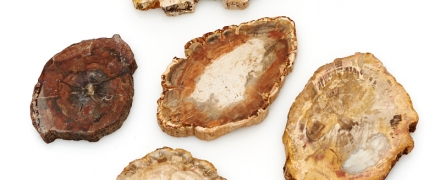open 10 am - 7 pm
laboratory is closed
Petrified wood

Yes, it happens on the jewelry market.
Petrified wood is a very beautiful material that has found its application in the jewelry industry, and is also often used to decorate the interior. The demand for this material on the market is associated with its unusual appearance, peculiar form, as well as picturesque replacement patterns. All these properties are directly related to the formation of a petrified tree in nature. It consists in the following: the tree is buried under a layer of precipitation, but it does not decompose due to a rather limited amount of oxygen. Numerous streams of water penetrating the sediment “deliver” various minerals to the tree. Subsequently, the organic compounds of the wood material are destroyed and only the stone remains, which repeats the original shape of the tree. Due to the fact that in the process of this metamorphosis all organic cells are gradually replaced by minerals, mainly quartz, the microscopic structure of the tree remains unchanged. Petrified wood is found in almost any color. Its color is associated with impurities of certain elements coming with solutions during the formation period. So green and blue can be associated with chromium, cobalt or copper, black - with carbon or manganese oxide, iron oxide contributes to the appearance of yellow and red hues, and pink or orange appears due to manganese. The pattern of each tree is unique and never repeats. Depending on the type of pattern, petrified trees are divided into homogeneous, lens, spotted, concentric-zonal and jet-shaped. The most common find of petrified trees is volcanic terrain. The most famous is the Petrifide Forest ("Petrified Forest") in Arizona. However, most of the petrified tree deposits are national parks or reserves, so there is no mining.
The pricing policy for petrified wood products is directly related to the size of the product and the complexity of its execution, as well as the quality of the material. Jewelry is most often cut by hand, therefore it is valued somewhat more expensive than interior products.
В геммологической практике бывают весьма увлекательные случаи с диагностикой ювелирных вставок
Но помимо редкости цвета и высокой стоимости таких камней, многие розовые камни выделяются одной замечательной особенностью – они проявляют плеохроизм, то есть в зависимости от положения осмотра камня он может иметь дополнительные оттенки – оранжевый или пурпурный.
Currently, gemstones are produced by two fundamentally different technological methods - the High Pressure - High Temperature method (“HPHT”, High-pressure & High-temperature) and the Chemical Vapor Deposition (“CVD”, Chemical vapor deposition) method. The "HPHT" method is the most tested classical synthesis method, which can be used both carbon deposition on diamond from flux melts and catalytic reactions. In "CVD" synthesis, diamond growth occurs on a seed during carbon deposition mainly from a gaseous medium at relatively low temperatures and pressures.
Jewelry and precious stones are just such a category of goods, when buying which you need to pay attention to many criteria.
Sogdianite is a rather rare mineral and more often it can be found as a collection material (moreover, in systematic collections), and it is extremely rare in jewelry.






